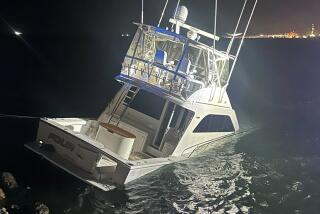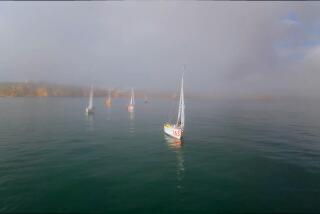It’s Smooth Sailing in ‘Water-Going Golf Carts’
- Share via
When McLaren Stewart, 79, bought his electric bay boat in 1973 there were only about half a dozen others in Newport Harbor. Heads turned whenever he ventured out upon the water.
“Mostly the thing that attracted attention was that the boat didn’t make any noise,” says Stewart, a retired Disney art director. “People couldn’t figure out what made it go. It’s just a water-going golf cart, really. When you’re not using it, you just plug it in to charge the batteries. Then, when you want to go out, you just unplug it and away you go.”
During the 15 years that Stewart has owned his boat, things have changed. Today, there are nearly 300 electric boats plying the waters of Newport Harbor, and most of the old jokes--”Hope your extension cord is long enough”--have long since disappeared.
“At first the boats were a curiosity,” Stewart says. “Now it seems like every other dock has one.”
The increased popularity is good news for Marshall (Duffy) Duffield, the 36-year-old boat-builder who designed and sold nearly every electric boat on Newport Bay.
Duffield was still a teen-ager when his father gave him $200 to buy an old electrical system from a golf cart and install it in the family boat.
Pretty soon Duffield and his friends were cruising the bay in what looked like an engineless, soundless motorboat.
“I’d be traveling down the bay, not making any noise or smoke and people would say, ‘What in the world is that? What makes it go?’ ”
One of those people was Ray Godber of the Trojan Battery Co. When Godber found out that Duffield’s boat was powered by Trojan batteries, he encouraged young Duffield to start marketing his “water-going golf cart.”
“Building that first boat was just something to do for fun. I never intended to be a businessman,” Duffield says.
But within three years, Duffield found himself selling boats to people such as McLaren Stewart, who wanted something simple and easy to operate. Stewart recalls that he bought his boat from Duffield before the young boat builder was even old enough to vote.
“At first the boats weren’t very well accepted,” Duffield says. “People thought of them as toys. And, yes, we got a lot of jokes.”
The 20-foot open boats with canvas canopies look a lot like any other boat. The primary difference is that the vessel is powered by a small electric motor, much like that original golf cart motor Duffield used back in 1970.
The boats, which come complete with a dozen golf cart-type batteries, charger and extension cord, plug into any regular 110-volt outlet. A “fuel gauge” on the helm station shows the skipper how much time remains before the boat needs recharging. Top speed is five to six knots. You can cruise the bay for about five hours at full speed on one charge, according to Duffield. At a crusing speed of 2.5 knots, you can go for about 15 hours.
The boats are designed to be used in protected waters such as harbors or lakes and are not recommended for use in the ocean. However, Duffield says he has cruised one all the way from Newport Beach to Long Beach. “It’s a real boat,” he says, “a 3,000-pound ocean-type boat. People think that if a wind comes up they’ll get blown backward. That’s not so.”
The only real limitation, Duffield says, is forgetting to charge your batteries.
“As long as you remember to plug it in when you get back to the dock, you don’t have to worry about anything else.”
About 1,240 watts of power (about the same as using a small electrical appliance) are needed to charge the boat, according to Duffield. “The amount of electricity used would be the equivalent to powering a 150-watt light bulb for 24 hours,” he says.
Dead batteries take about 12 hours to charge to full or about three hours of charging for each hour that you have used the boat. “You don’t have to compute anything though,” Duffield says. “The automatic charger does it for you. You just plug it into a standard household circuit with a heavy-duty extension cord.”
Batteries last from three to six years, depending upon maintenance and use. Maintenance consists of keeping the batteries charged and keeping the battery water topped off.
The electric motor has only one moving part and should not require maintenance or repairs, Duffield says. “Just think about your refrigerator motor. How often do you have to replace it?”
Duffield admits that the idea for an electric boat is not new--merely recycled.
“I thought I was the inventor until I heard about the old Elco boats, which were made by the Electric Boat Co. in Connecticut around the turn of the century,” Duffield says.
Elco (The Electric Launch Company) built a small (15- to 16-foot) electric boat that was a featured attraction at the 1893 World’s Fair, according to Jim Reyburn, news and information specialist with the Electric Boat Division of General Dynamics, Groton, Conn. “Even the czar of Russia had one,” he said.
The company, which went on to build large motor yachts and PT boats during World War II, has not produced electric launches for about 90 years, Reyburn says. Today, as a division of General Dynamics, the company builds nuclear submarines.
Electric boats make up a very small part of the boat market nationwide. Some are sold in Florida and the northeast, Duffield said. Here in Southern California, Duffield and his company, Duffield Marine in Newport Beach, design or sell most of the electric-powered vessels in this area. Schock Boats in Newport Beach sells a Duffield-designed 18-footer with surrey top called the Newport Electric Packet that retails for $16,500.
Base price for the Duffy 20, which can accommodate up to 12 adults, is also $16,500. With options, including an auto pilot, Plexiglass windows, custom carpeting, stereo and other extras, the price goes up to around $24,000. Duffield has just designed a 16-footer that he hopes to sell for under $10,000.
“This is a life style we’re selling,” Duffield says. “A way of socializing and relaxing.”
More to Read
Sign up for The Wild
We’ll help you find the best places to hike, bike and run, as well as the perfect silent spots for meditation and yoga.
You may occasionally receive promotional content from the Los Angeles Times.






